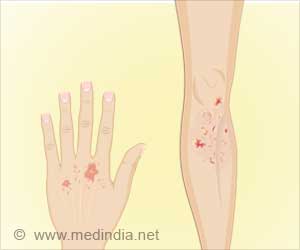
The most common form of eczema in children is atopic dermatitis, which usually begins very early in life. It often occurs in infants and young children. While most people develop atopic dermatitis before age five, it can also begin during puberty or later.
For many children, eczema goes away with time. However, Dr. Yu says about half of the children who get this skin condition will have it as an adult. While there is no way to know whether the eczema will go away or become a lifelong condition, early diagnosis and treatment can prevent the condition from getting worse. The more severe it becomes, the more difficult it can be to treat, and more likely it will persist into adulthood.
According to Dr. Yu, sometimes eczema is mistaken for allergic contact dermatitis, which occurs when a person’s immune system recognizes an allergen and responds to it. This can result in several skin symptoms which are similar to eczema, including a rash and discoloration, dryness, tenderness, burning or stinging, or in severe cases, blisters.
The allergens that children are most likely to be allergic to include metals such as nickel and cobalt, which can be found in costume jewelry and clothing such as belt buckles and jean snaps, as well as toys, furniture, school chairs.
Fragrances and preservatives are two other common allergens. These can be found in personal care products that families use, such as body washes and shampoos, as well as laundry detergents. Additionally, while fabrics themselves are rarely allergens, the chemicals and dyes used to treat them can cause an allergic reaction. The most common dye allergen is a dye called disperse blue dye, which is used to dye synthetic fabrics like polyester and nylon. Disperse blue dye is rarely used in 100 percent cotton, bamboo, silk, and other natural fiber clothing. “In addition to metals, fragrances and preservatives, dermatologists are seeing two emerging allergens affecting children —adhesive allergens, which are commonly used in wearable blood glucose monitors, and an allergen from a chemical used in shin guards,” said Dr. Yu. “Children who are allergic to the wearable blood glucose monitors often develop an itchy rash underneath, so they typically need to switch the location of their monitor every two to three days. If your child’s shin guards cause irritation, dermatologists recommend switching shin guards to avoid the suspected allergen or putting a barrier, like a sock, between their skin and skin guard.”
To determine if a child’s rash if being caused by an allergy or another skin condition like eczema, Dr. Yu says it important to know when the child started developing the rash, if there is a family history of skin conditions like eczema, and where the rash is located on the child’s body. Allergic contact dermatitis tends to affect unusual locations like the eyelids, tops of the feet or the back of the hands, while eczema is more likely to be found on the back of the knees, wrist, neck, and inner elbows.
“To diagnose allergic contact dermatitis, your board-certified dermatologist may perform a special type of allergy testing called patch testing,” says Dr. Yu. “While eczema can be effectively managed, the best way to treat allergic contact dermatitis is to avoid the allergen once it has been identified.”
READ RELATED: Tiffany Darwish Height, Weight, Age, Body Statistics
Since allergic contact dermatitis can be responsible for worsening eczema, Dr. Yu recommends avoidance of common allergens such as fragrances. He recommends using fragrance-free rather than unscented products. Fragrance-free and unscented have different meanings. Unscented means that a fragrance is masked, so you cannot smell it, but it may still contain fragrances that can still irritate the skin. Fragrance-free means the product is free of all fragrances, even ones that you cannot smell. Dr. Yu advises to always check the label because the cosmetic industry is poorly regulated.
In addition, Dr. Yu advises that people be careful when choosing products that are labeled as “clean” or “natural” because they are also not regulated.
“The Federal Drug Administration does not have a specific set of guidelines to say that a product is clean or natural. These are just buzzwords that companies put on products to tell consumers that some of the ingredients are potentially derived from natural sources,” said Dr. Yu. “As I tell my patients, although poison ivy is natural, you wouldn’t want to use a product containing it.”
Dermatologists are the experts in the diagnosis and treatment of both eczema and allergic contact dermatitis. If you have questions about a rash or a product that may be causing a rash, make an appointment to see a board-certified dermatologist.
Source: Newswise
Source:







